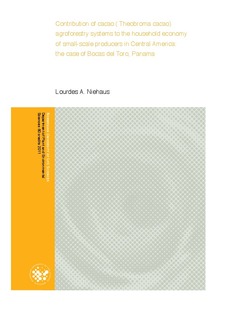| dc.description.abstract | Cacao (Theobroma cacao L.) is the main cash crop of Ngöbe-Buglé indigenous
communities in Bocas del Toro, Panama. Their traditional polycultures include many other food crops for family consumption, but there is no actual description of their diversity, productivity or contribution to household economy. This study was designed to determine the value and allocation of multiple products, depict floristic composition of cacao
agroforestry systems (AFS), assess socio-economic performance, and propose scenarios for poverty alleviation. Mixed quantitative and qualitative research methods determined productivity of all species in thirty-nine cacao AFS. Annual Net Cash Flow (NCF) and Family Benefit (FB) were calculated. Bocatorean cacao AFS include 139 planted and naturally occuring species, among them considerable volumes of high-value timber. Functional markets for most products are missing. Smallholders generate most income (52%) from external sources. Cacao AFS bring in 19%; other farming activities account for
the remaining 29%. Percent annual value from cacao AFS is mostly allocated to family
consumption (45%) or to feed farmyard animals (12%); sales account for 43%. The ratio of annual FB/ha to NCF/ha is 3.8. Returns to labour were $13.6 for FB and $3 for NCF, which denotes much greater productivity than measured in conventional financial terms and demonstrates the importance of cacao AFS for family food security. Alternatives to a onecrop
approach are presented as income generation opportunities. Improved communal harvesting and forest management can foster timber and organic produce sales in nearby urban areas. High value fruits and spices can be introduced to diversify agrobiodiversity and markets. Better crop management and grafting of improved genetic material will
increase cacao yields. Procuring payments for ecosystem services would benefit
landowners. Sparking interest in the younger population would optimize the development of human capital, creativity, entrepreneurism, and trade in a province where lack of job opportunities keeps almost 70% of the population under the poverty line. | no_NO |
